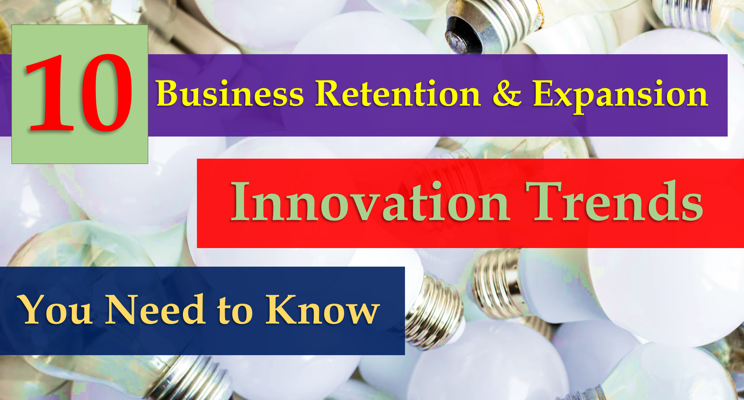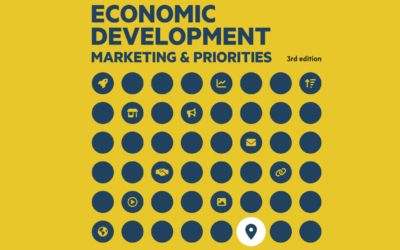
Traditional Business Retention and Expansion (BRE) has been defined by annual visits and surveys of private sector businesses. This model doesn’t work well for the business or the economic development organizations in today’s global business dynamic.
A group of BRE thought leaders gathered in Atlanta to present the challenges and innovations occurring in BRE to hundreds of economic development practitioners in attendance. The findings were enlightening, offering new strategic practices to add to BRE efforts as well as recommendations to throw away old practices that no longer work.
The following are key issues that BRE professionals need to address to be more effective, efficient, and modern in their approach to serving local businesses.

1. Industry Roundtables and Focus Groups Work
Companies are working collaboratively and not in isolation. BRE professionals have an important role in bringing businesses in an industry together to discover shared problems and identify collective solutions. This is a different approach than traditional meetings with individual companies which are not as productive.
Bringing businesses in an industry together helps them realize that they do not have unique problems and that the challenges they have are consistent across their industry. It also surfaces common challenges an industry has that the local government can address and solve. In addition, often business professionals don’t know each other locally and through these meetings networking occurs that can lead to business collaborations.

2. The Business Survey Should Die
Surveys are a siloed experience based on standardized questions and feedback from just one business. None of the experts believed that surveys were effective for BRE. Although the information may create standardized data trends for economic development organizations, these survey meetings don’t address the expectation of modern businesses. Instead, businesses want fast action from the BRE/government people they are meeting with because they need business solutions immediately. The concept of “acting as fast a business” needs to be core to BRE programs because companies are having to move faster to keep up, stay relevant, and continue competitiveness. If businesses don’t see an immediate response as a result of their meeting with a BRE professional they are not going to meet with them again.

3. Success Measurements are Changing Due to Automation and Labor Shortages
Every community is struggling with the issue of a workforce shortage at their local businesses. Businesses are responding to this challenge by implementing technology and automation to replace processes that were previously done by people.
This has an impact on BRE success metrics because the measurement of job creation as an indicator of success is in conflict with the trend that businesses are taking to replace jobs with technology. BRE professionals are seeing multi-million-dollar capital investments to increase productivity and reduce employee headcount. This trend is not aligned with the traditional BRE metric of job creation.

4. Meetings Must Be Earned With Value
Businesses are too busy to schedule meetings with BRE professionals unless that meeting is going to deliver direct value to the business. To be able to convince a business they should take a meeting, you need entice the business with an “intention” of how you will add value to them and what will be accomplished at the meeting. “Economic development agencies haven’t kept up with the trends of the sectors that they are working with,” said Dale Wheeldon, President & CEO, British Columbia Economic Development Association. Instead, BRE pros need to go into meetings with an understanding of their industry and what the business is talking about instead of having the business educate the BRE pro.
Economic developers have aspired to be a jack of all trades to be effective, but today they must become deep experts in the sectors their local businesses operate in. General expertise in an industry is no longer enough.

5. Engagement with Business is More Than Once a Year
BRE pros used to speak with a business once a year. Now there are multiple touch points in different methods including business gatherings with elected officials, industry roundtables, focus groups, town halls, women’s business luncheons (in which the government invites entrepreneurs to a table they have reserved), and creating CEO talks. The change is that instead of going to visit the business you are plugging the business into the community.
6. The Key to Serving More Businesses is Technology
A weakness of BRE programs is that only a small portion of all the businesses in a community are served because most effort are limited by the number staff and hours people can work. Although new types of BRE initiatives like Business Walks have expanded the number of businesses contacted, even the most successful walks reach only a few hundred businesses. Internet-delivered technology is the solution to be able to provide a new type of BRE assistance to a larger constituency of local businesses. These solutions include data and information to help businesses better understand their performance, find customers, and improve operations.

7. Business Walks Expand Your Footprint
Business walks for BRE started in Sacramento and it is now growing to be used in many communities as a way to meet with a large number of businesses with a large number of city staff, chambers of commerce, workforce development agencies, and elected officials. These people are gathered and trained before the walk and then sent out to walk to meet businesses along commercial corridors, industrial parks, and neighborhoods. They walk into the businesses and ask them a few questions: 1. How is business? 2. What do you like about doing business here? 3. What challenges are you facing? 4. What are some strengths of the community? 5. What could it be doing better? A key goal of this process is to spend 5 to 10 minutes to meet the business and build trust.
Because there are so many volunteers and the time of the meeting is so short it enables a large quantity of contact. This is a way to reach more businesses because BRE programs focused on annual surveys typically reach a much smaller number of businesses. As an example, the Business Walk team of a larger sized city of 300,000 were able to speak with 330 businesses in 3 hours. However, if an organization does not have the capacity to follow up to quickly to address the issues that businesses bring up, Business Walks should not be implemented. Otherwise the businesses will see the interaction as a waste of time.

8. Effective BRE Leads to Business Attraction and FDI
By deepening relationships with local businesses opportunities for attracting businesses by turning local businesses into ambassadors for attracting businesses that may be their suppliers or customers. Understanding supply chains can lead to identifying businesses that can be recruited to your region.
Through BRE interviews with foreign businesses already located in your community you can identify the elements of what makes your community a good location for a business headquartered in a different country. These advantages can be used to identify other businesses in their home countries that may also want to leverage these benefits which will result in Foreign Direct Investment in your area.

9. Sometimes You Need to Get Out of the Way
Economic developers may hypothesize about what businesses and industries need but that can be more effective at identifying problems and solutions by putting industry experts in a room and letting them hash out the problems. BRE pros should catalyze the business leaders through discussion, questions, and inviting spirited dialogue to enable the discovery. Then, the economic developers can come back to engage in the places they can create solutions.

10. Disaster Recovery is Business Assistance on Steroids
Communities are experiencing disasters such as floods, tornadoes, hurricanes, fires, and earthquakes that have disastrous impacts on local businesses. BRE programs need to be prepared to respond to how they can get their local economy back to business following these types of disasters because they are occurring more frequently. In addition, it is important that the economic development organizations are also prepared for disaster and have all of their information in the cloud so they are not relying on information stored locally on hard drives that can get wiped out in a disaster.



